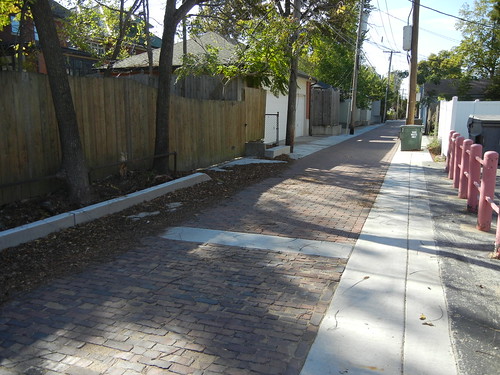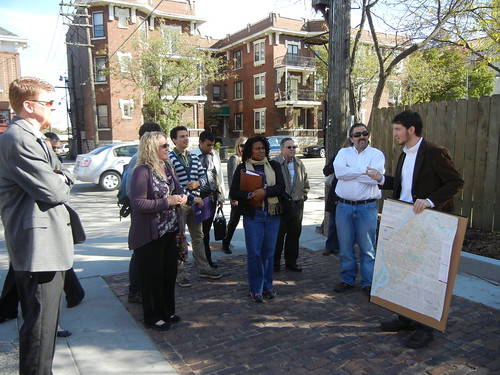by Michael R. Allen
On Friday I participated in a mobile workshop on the South Grand business district that was part of the annual conference American Planning Association Missouri Chapter. The workshop started with a driving tour from the Chase Park Plaza (conference venue) that included Kingshighway, Southwest Garden, Shaw and Tower Grove Park. After the tour, over lunch at Mojo, participants heard about area history from planner and historian Mark Abbott and the current streetscape project from Rachel Witt of the South Grand Community Improvement District and Mary Grace Lewandowski of the East-West Gateway Council of Governments.
Then the group headed out for a tour of South Grand guided by Andrew, Rachel and myself. While many excellent buildings were included alongside the quickly-nearing-completion improvements to Grand’s sidewalks, the stand-out of the tour was an alley. That is right — the tour ended at the alley between Humphrey and Utah streets west of Grand.

The reason for including the alley, as Andrew Murray eloquently stated, was that it demonstrated very basic principles of sustainability in the built environment. Alleys are instruments of vehicular utility, and their presence in St. Louis is taken for granted. However, many are in rough shape because their paving bricks have been layered with asphalt pavings. City alleys often settle with the bricks, and become uneven and difficult to maintain. Meanwhile, they deflect water onto parking pads, into garages and onto streets.

This alley in Tower Grove South has been returned to sound condition in a way that is both historically and ecologically informed. Alderwoman Jennifer Florida (D-15) and the Streets Department found funds to rebuild the alley by paving it with historic paving bricks, gloriously purple-red and gently chipped through decades of urban life, reclaimed from the alley itself. Set on a new substrate, the bricks are level but also are water permeable. The only deviation from historic conditions is that the design included a concrete perimeter to buffer the paving from existing outbuildings and curbs.
This alley not only is “green” but also reflects its historic character by bringing its original paving material back to the surface. The result is durable and attractive, and maintenance simple. Sustainability need not be a headlong rush into trendy new building technology, when time-proven materials and methods are at hand. Our tour ended by reminding participants that existing infrastructure already embodies today’s planning standards. Modular water-permeable paving? We already did that — one hundred years ago.

5 replies on “A “New” Brick Alley in Tower Grove South”
One would think historic preservation and sustainability blocs would collaborate on utilizing deconstructed materials in rehabilitation and stabilization. Is it possible for a neighborhood to maintain the robustness of its historic district designation by incorporating elements of a deconstructed building into adjacent properties? Is it possible for sustainability certifications and incentives to recognize the importance of sourcing culturally and architecturally relevant materials for stabilization projects? Should we be changing policy to invite these innovations into the array of options? Initiatives in the vein of this alley indicate there is more than just a passing curiosity in material reuse. This may mean certain members of advocacy and booster communities relax some of their restrictions on how neighborhoods are strengthened and stabilized, instead supporting trajectories that unite pragmatism and creativity. I suspect we will start having this serious conversation.
As an alley lover, it saddens me to see alleys covered under asphalt, but realize homeowners demand smooth travels. However, I think smooth alleys create getaway lanes for those contemplating nefarious activity, and other neighbors just speed down smooth alleys creating danger. Finally, the city’s brick alleys were fine for decades, until the one man trash truck showed up to save labor costs during the Schoemehl administration. The trucks are heavier, with all that extra hydraulics, and the alleys took a beating. Not a good trade off, short sighted at best.
Thanks for the reminder of why we got so many asphalt alleys. Maybe the reduction in trash collection days will help us with efforts to restore brick alleys.
Resource scarcity (building material and money) means we need to save what we can but also that we can’t save every building. We need to make sure that when we do tear something down, we are smart about saving materials and keeping them in the community. Otherwise our wealth is trucked away to the benefit of other cities, and we are left with diminished sense of place too.
It’s high time that St. Louis pursues deconstruction instead of demolition. Preservation comes in many forms.
Word.